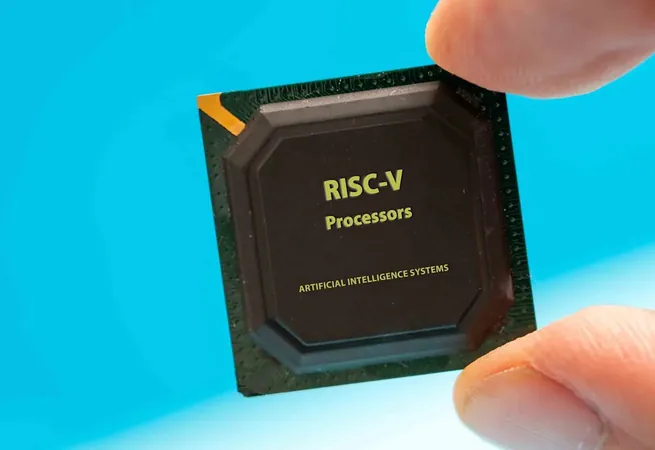
Hong Kong’s Investment in RISC-V: A Bold Bet on Semiconductor Innovation
2025-03-21
Author: Ling
Introduction
In a significant move aimed at enhancing its semiconductor capability, Shanghai-based startup StarFive has secured financial backing from the Hong Kong government. The support comes as China seeks to fortify its chip industry by investing in the promising open-source RISC-V architecture, especially amid increasing trade tensions with the United States.
Investment Details
StarFive, which has been a key player in the RISC-V landscape for the past six years, announced the investment from the Hong Kong Investment Corporation (HKIC). This organization is responsible for managing HK$62 billion (approximately US$8 billion) to stimulate innovation within the city. According to Thomas Xu Tao, StarFive's founder and CEO, this partnership is essential for promoting the practical applications of RISC-V chips in Hong Kong.
The Evolution of RISC-V
"RISC-V has evolved beyond its initial research phase and is now focused on real-world applications," explained Xu. "However, implementing these use cases can be quite challenging at the beginning, necessitating guidance from the government."
Competitive Landscape
RISC-V, pronounced "risk five," is an open-source instruction set architecture that provides developers the flexibility to customize their chip designs. While it currently faces stiff competition from established players like Intel's x86 and Arm Holdings, RISC-V's open-source nature alongside its energy efficiency has been attracting attention.
China's Strategic Shift
China is heavily investing in RISC-V to decrease reliance on foreign technology as the US tightens its grip on advanced chip exports. Hong Kong is enthusiastic about developing its own RISC-V ecosystem to boost economic growth and solidify its role in the broader Chinese semiconductor industry. "The design and application of RISC-V chips are crucial for Hong Kong's strategic planning for the future," emphasized Paul Chan Mo-po, the city’s finance chief, in his recent blog.
Notable Projects
One of StarFive’s notable projects is the Towngas Chip, a RISC-V processor that made its debut in November 2022 in collaboration with the Hong Kong and China Gas Company. This chip is set to be integrated into smart gas meters across Hong Kong as early as the second quarter of 2023. However, the scope of the Towngas Chip remains limited, leading industry experts like Alan Chan of Full Vision Capital to suggest that the HKIC partnership might pave the way for broader applications in the future.
Future Developments
StarFive's ambitions don’t stop there; they are also working on a more advanced 12-nanometre RISC-V processor named “Lion Rock,” after a prominent Hong Kong landmark. Xu indicated that mass production for this processor is slated to start by the end of this year or early next year.
Geopolitical Context
The urgency for China to develop its chip-making capabilities has been underscored by recent geopolitical events. The U.S. government imposed a seven-year export ban on ZTE, which spurred Chinese investors, including Peter Lee Ka-kit of Full Vision Capital, to nurture home-grown chip firms. Chan noted that Lee recognized early on the necessity for China to cultivate its semiconductor technology.
Broader Industry Initiatives
Bolstering this movement, the Chinese Academy of Sciences is set to unveil a RISC-V-based central processing unit, the XiangShan, later this year. On another front, Alibaba’s semiconductor division, T-Head, recently launched the XuanTie C930, a server-grade RISC-V processor aimed at high-performance applications, including data centers and autonomous vehicles.
Conclusion
With substantial government support and a clearer path toward reducing technological dependencies, the future of RISC-V technology looks promising in Hong Kong and across China. As these advancements unfold, stakeholders are eagerly watching how this open-source architecture will reshape the global semiconductor landscape.


 Brasil (PT)
Brasil (PT)
 Canada (EN)
Canada (EN)
 Chile (ES)
Chile (ES)
 Česko (CS)
Česko (CS)
 대한민국 (KO)
대한민국 (KO)
 España (ES)
España (ES)
 France (FR)
France (FR)
 Hong Kong (EN)
Hong Kong (EN)
 Italia (IT)
Italia (IT)
 日本 (JA)
日本 (JA)
 Magyarország (HU)
Magyarország (HU)
 Norge (NO)
Norge (NO)
 Polska (PL)
Polska (PL)
 Schweiz (DE)
Schweiz (DE)
 Singapore (EN)
Singapore (EN)
 Sverige (SV)
Sverige (SV)
 Suomi (FI)
Suomi (FI)
 Türkiye (TR)
Türkiye (TR)
 الإمارات العربية المتحدة (AR)
الإمارات العربية المتحدة (AR)